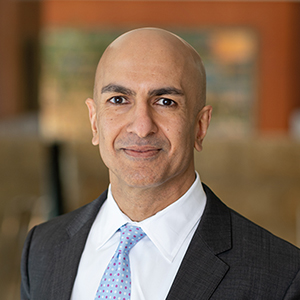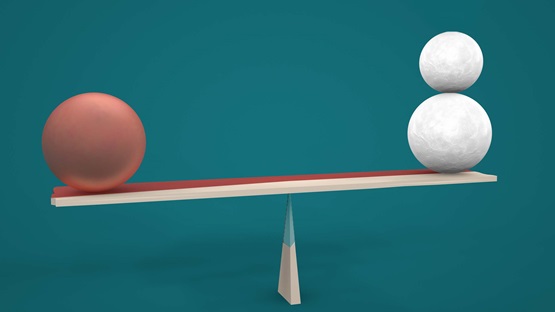This essay is also available on Medium.
As I’ve discussed publicly for some time, I have been trying to make sense of the mixed signals the economy is sending. When I travel across the Ninth Federal Reserve District, the overwhelming concern I still hear from businesses of all sizes is one of a labor shortage. And, yes, wages are climbing, but on average they haven’t been keeping up with inflation. Real wages have been falling. Is this really a tight labor market? Corporate profits are up, and the labor share of income is actually declining. If the labor share isn’t going to increase in this “tight” labor market, when will it?
I’ve also been wrestling with why we missed this high inflation and what we can learn going forward. To state clearly, I was solidly on “Team Transitory,” so I am not throwing stones. But many of us—those inside the Federal Reserve and the vast majority of outside forecasters—together made the same errors in, first, being surprised when inflation surged as much as it did and, second, assuming that inflation would fall quickly. Why did we miss it?1
A Useful Analogy
I have come up with an analogy that has helped me to make sense of the mixed economic signals we are seeing, and that I believe sheds light on why I didn’t see the high inflation coming. This story, then, has implications for learning from our miss and potentially for incorporating these lessons going forward.
One feature of ride-sharing apps such as Uber and Lyft is “surge pricing”: When an unexpected rainstorm hits, people don’t want to walk or ride bikes. They call for cars, and the price of a ride can surge from, say, $20 to $90. The high price accomplishes two goals: First, it reduces demand, and second, it incentivizes all available drivers to come out and increase supply. The market then clears at the elevated price. I don’t consider surge pricing to be nefarious. I consider it economically necessary given supply and demand dynamics.
Imagine a rainstorm hits, and the price surges from $20 to $90. But imagine, in my analogy, the ride-sharing company owns all the cars, and the drivers are its employees. When the storm hits, the company notifies all their drivers that they will pay time and a half. So, all the drivers come out to drive. The company doesn’t raise wages even more because they are car constrained: All their cars are deployed.
My story is of course too simple—just a demand surge, rather than both increased demand and disrupted supply—but the resulting characteristics resemble the economy we have been experiencing: Prices soar. Corporate profits climb. Income for drivers climbs, but not as much as prices. Real wages actually fall. Even though worker incomes are up, labor’s share of income is down. Labor markets are tight, but capital is the constraint on supply. Inflation has soared, but it soared because of supply/demand dynamics—what I will call “surge pricing inflation.” Economists would say the market hit the vertical part of the supply curve.
And this is key to our miss: The inflation in this example is not driven by the two primary sources that traditional Phillips-curve models used by policymakers, researchers, and investors consider: (1) labor market effects via unemployment gaps, and (2) changes to long-run inflation expectations.
In these workhorse models, it is very difficult to generate high inflation: Either we need to assume a very tight labor market combined with nonlinear effects, or we must assume an unanchoring of inflation expectations. That’s it. From what I can tell, our models seem ill-equipped to handle a fundamentally different source of inflation, specifically, in this case, surge pricing inflation.
This is not a criticism of economists inside or outside the Fed, or of my fellow policymakers. It is meant to be an honest assessment of what we missed and why we missed it (and why so many of us missed it the same way) in order to shed light on what we should learn going forward.
My staff pushed back on me when I made these arguments to them. They said: “shocks” hit the economy, both demand shocks and supply shocks. Shocks such as COVID, supply chain disruptions, the Delta wave, the Omicron wave, missing workers, unprecedented fiscal stimulus, and the war in Ukraine. And shocks, by definition, are unforecastable.
That is true, and indeed I recognize that we experienced very unusual shocks. That said, I see a couple problems with dismissing the miss because of shocks. First, because shocks are unforecastable, it absolves us from needing to learn from this experience and do better in the future. And second, I believe that even if we had been able to identify all the shocks in advance, I don’t think our workhorse models would have come anywhere close to forecasting 7 percent inflation. I think the root of our miss is that our models are not currently equipped to forecast the surge pricing inflation we are experiencing.
So, if you accept my story as an explanation for what we are seeing now and why we missed the high inflation, I think there are two implications for us going forward:
- This is a challenge for economists inside and outside the Fed: Can we develop frameworks and tools to analyze and potentially forecast inflation outside of labor market and expectations channels? Specifically surge pricing inflation, but potentially others as well?
- Our new monetary framework, which I strongly support, and the one it replaced seem to be built around the same two fundamental sources of inflation that I have been discussing in this essay: the labor market and inflation expectations. If we can deepen our analytical capabilities surrounding other sources and channels of inflation, then we might be able to incorporate whatever lessons we learn into our policy framework going forward. I do not agree with some who suggest our new framework is what caused us to miss this surge in inflation; most advanced-economy central banks around the world also missed forecasting high inflation using their existing policy frameworks.
A common criticism of policymakers is that they always focus on the last crisis. This is said to be true for both economic policymakers as well as national security policymakers. The criticism is that the next crisis will be different, and yet it’s human nature to focus on the recent past. I don’t agree with these arguments. Policymakers actually do need to understand and close the vulnerabilities exposed in the last crisis so that the same crisis isn’t repeated. The Federal Aviation Administration actually did have to order the hardening of cockpit doors so it would be harder for terrorists to hijack planes after 9/11.
Thoughts on Current Monetary Policy
I understand it will take some time to develop models that fully account for these different sources of inflation. Meanwhile, we still have a responsibility to bring inflation back down to our target. One may ask why tightening monetary policy is the right response to what I described as surge pricing inflation. Unfortunately, the initial surge in inflation is leading to broader inflationary pressures that the Federal Reserve must control. For example, nominal wage growth has grown to 5 percent or more, which is inconsistent with our 2 percent inflation target given recent trend productivity growth. Monetary policy is the appropriate tool to bring the labor market back into balance.
I see three steps in our policy process to bring inflation back down to 2 percent. The first step was to rapidly raise rates, which we did in 2022. Once we understood that our models were not capturing the inflationary dynamics noted above, we simply needed to raise rates aggressively until we were confident inflation had peaked and we weren’t falling further behind.
While I believe it is too soon to definitively declare that inflation has peaked, we are seeing increasing evidence that it may have. In my view, however, it will be appropriate to continue to raise rates at least at the next few meetings until we are confident inflation has peaked.
Once we reach that point, then the second step of our inflation fighting process, as I see it, will be pausing to let the tightening we have already done work its way through the economy. I have us pausing at 5.4 percent (see figure), but wherever that end point is, we won’t immediately know if it is high enough to bring inflation back down to 2 percent in a reasonable period of time. Once we see the full effects of the tightened policy, we can then assess whether we need to go higher or simply remain at that peak level for longer. To be clear, in this phase any sign of slow progress that keeps inflation elevated for longer will warrant, in my view, taking the policy rate potentially much higher.
The third step, as I see it, is to consider cutting rates only once we are convinced inflation is well on its way back down to 2 percent. Given the experience of the 1970s, the mistake the FOMC must avoid is to cut rates prematurely and then have inflation flare back up again. That would be a costly error, so the move to cut rates should only be taken once we are convinced that we have truly defeated inflation.
Endnotes
1 These comments are my own and do not necessarily represent the view of the Federal Open Market Committee (FOMC) or others in the Federal Reserve System.




